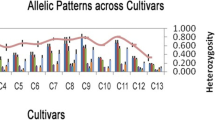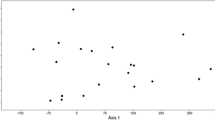Abstract
Citrus plant species are among the most important and consumed fruit plants throughout the world. In general, genetic diversity investigations in all Citrus species and varieties are in hand in order to add to the knowledge of these important plant species. The sweet orange cultivars (Citrus sinensis), are among the most wanted among Citrus species. Various genetic diversity investigations by using different molecular markers have been performed in different regions of the world. We investigated 23 cultivars of sweet oranges available in Iran and two out-group cultivars produced by crossing Lemon and Kumquat. We used Start Codon Targeted (SCoT) molecular markers for genetic study. The studied cultivars produce 64 SCoT loci or bands. In total each cultivar studied contained 8–29 SCoT bands and six cultivars had 1–2 private/specific bands due to their peculiar genetic structure. Genetic diversity parameters were determined in these cultivars and revealed that the genetic polymorphism varied from 6.15% into 44% in the Studied sweet orange trees. We identified many loci with high discrimination power (> 0.80) in SCoT marker. Analysis of molecular variance (AMOVA) revealed significant genetic difference among these cultivars, and pair-wise AMOVA identified those sweet oranges which differed genetically from each other. Unweighted pair group method with arithmetic mean dendrogram of the studied samples separated most of the cultivars and their replicates in distinct clusters. STRUCTURE analysis revealed genetic structure of sweet oranges, showing their genetic similarities versus genetic uniqueness. We could differentiate some of Thompson cultivars, coming with different origins or locality. It held true for red blood and Jaffa oranges too. We identified few potential hybrids in the country. These findings will be used in future sweet orange conservation and breeding.



Similar content being viewed by others
References
Abedinpour H, Babaeian Jelodar N, Ranjbar G, Golein B (2015) Study of genetic diversities and relatedness of Iranian Citrus genotypes using morphological and molecular markers. J Plant Mol Breed 3(1):35–49
Aydin U, Turgut Y (2012) Genetic diversity in Citrus. Genetic Diversity in Plants pp 213–230
Ben Abdelaali S, Saddoud O, Abdelaali NB, Hajlaoui MR, Mars M (2018) Fingerprinting of on-farm conserved local tunisian orange cultivars (Citrus sinensis (L.) osbeck) using microsatellite markers. Acta Biol Cracov Bot 60:83–93
Chen C, Bowman KD, Choi YA, Dang PM, Rao MN, Huang S, Soneji JR, McCollum TG, Gmitter FG Jr (2008) EST-SSR genetic maps for Citrus sinensis and Poncirus trifoliate. Tree Genet Genomes 4:1–10
Collard BCY, Mackill DJ (2009) Start codon targeted (SCoT) polymorphism: a simple novel DNA marker technique for generating gene-targeted markers in plants plant. Mol Biol Rep. 27:86
Debbabi OS, Mezghani N, Madini M, Abedelaali NB, Bouhlel R, Ksia A, Mars M (2014) Genetic diversity of orange fruit (Citrus sinensis L.) cultivars in Tunisia using AFLP markers. IJAAR 5(1):7–15
Evanno G, Regnaut S, Goudet J (2005) Detecting the number of clusters of individuals using the software STRUCTURE: a simulation study. Mol Ecol 14:2611–2620
Falush D, Stephens M, Pritchard JK (2007) Inference of population structure using multilocus genotype data: dominant markers and null alleles. Mol Ecol Notes 7:574–578
Fang DQ, Roose ML (1997) Identification of closely related Citrus cultivars with inter simple sequence repeat markers. Theor Appl Genet 95:408–417
Golein B, Talaie A, Zamani Z, Ebadi A, Behjatnia A (2005) Assessment of genetic variability in some iranian sweet oranges (Citrus sinensis (L) Osbeck) and Mandarins (Citrus reticulata Blanco) using SSR markers. Int J Agric Biol 7:167–170
Hammer ØM, Harper DAT, Ryan PD (2012) PAST: paleontological statistics software package for education and data analysis. Palaeontol Elect 4:9
Hvarleva T, Kapari-Isaia T, Papayiannis L, Atanassov A, Hadjinicoli A, Kyriakou A (2008) Characterization of Citrus cultivars and clones in Cyprus through microsatellite and RAPD analysis. Biotechnol Biotechnol Equip 22:787–794
Jannati M, Fotouhi Ghazvini R, Abad A, Zivar Salehi (2009) Genetic diversity analysis of Iranian Citrus varieties using micro satellite (SSR) based markers. J Hortic For 1:120–125
Krisman M, Jakše J, Barièeviè D, Javornik B, Prošek M (2006) Robust CTAB-activated charcoal protocol for plant DNA extraction. Acta Agric Slov 87:427–433
Lamine M, Chebaane A, Mliki A (2015) Genetic diversity analysis in Tunisian Maltaise orange (Citrus sinensis L.). J New Sci 14(2):438–448
Meirmans PG, Van Tienderen PH (2004) GENOTYPE and GENODIVE: two programs for the analysis of genetic diversity of asexual organisms. Mol Ecol Resour 4:792–794
Novelli VM, Cristofani M, Souza AA, Machado MA (2006) Development and characterization of polymorphic microsatellite markers for the sweet orange (Citrus sinensis L. Osbeck). Genet Mol Biol 29:90–96
Peakall R, Smouse PE (2006) GENALEX 6: genetic analysis in excel population genetic software for teaching and research. Mol Ecol Not 6:288–295
Penjor T, Yamamoto M, Uehara M, Ide M, Matsumoto N, Matsumoto R, Nagano Y (2013) Phylogenetic relationships of Citrus and its relatives based on matk gene sequences. PLoS ONE 8(4):e62574
Podani J (2000) Introduction to the exploration of multivariate data, Leide, Netherlands
Pritchard JK, Stephens M, Donnelly P (2000) Inference of population structure using multilocus genotype Data. Genetics 155:945–959
Rao VR, Hodgkin T (2002) Genetic diversity and conservation and utilization of plant genetic resources. Plant Cell Tiss Org 68:1–19
Saboori S, Noormohammadi Z, Sheidai M, Marashi SS (2019) SCoT molecular marker and genetic fingerprinting of data palm (Phoenix dactylifera L.) cultivars. Genet Resour Crop Evel 67:73–82
Sagawa CHD, Cristofani-Yaly M, Novelli VM, Bastianel M, Machado MA (2018) Assessing genetic diversity of Citrus by DArT_seq™ genotyping. Plant Biosyst 152(4):593–598
Satya P, Karan M, Jana S, Mitra S, Sharma A, Karmakar PG, Ray DP (2015) Start codon targeted (SCoT) polymorphism reveals genetic diversity in wild and domesticated populations of ramie (Boehmeria nivea L. Gaudich) a premium textile fiber producing species. Meta Gene 3:62–70
Tabasi M, Sheidai M, Hassani D, Koohdar F (2020) DNA fingerprinting and genetic diversity analysis with SCoT markers of Persian walnut populations (Juglans regia L.) in Iran. Genet Resour Crop Evol 67:1437–1447
Weising K, Nybom H, Wolff K, Kahl G (2005) DNA fingerprinting in plants. In: Principles, methods, and applications. 2nd ed. Taylor & Francis, Boca Raton, Florida
Author information
Authors and Affiliations
Corresponding author
Ethics declarations
Conflict of interest
The authors declare that they have no conflict of interest.
Additional information
Publisher's Note
Springer Nature remains neutral with regard to jurisdictional claims in published maps and institutional affiliations.
Rights and permissions
About this article
Cite this article
Juibary, P.L., Seyedmehdi, F.S., Sheidai, M. et al. Genetic structure analysis and genetic finger printing of sweet orange cultivars (Citrus sinensis (L.) Osbeck) by using SCoT molecular markers. Genet Resour Crop Evol 68, 1645–1654 (2021). https://doi.org/10.1007/s10722-020-01092-2
Received:
Accepted:
Published:
Issue Date:
DOI: https://doi.org/10.1007/s10722-020-01092-2




